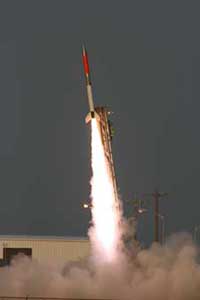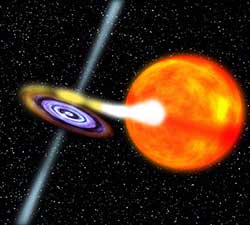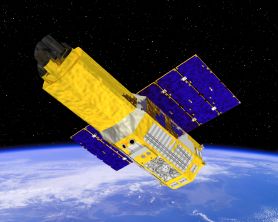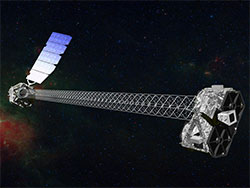X-ray Astronomy
X-ray Astronomy

A sounding rocket launch. (Credit: NASA)
The study of astronomical objects at the highest energies of X-rays and gamma rays began in the early 1960s. Before then, scientists knew that the Sun was an intense source in these wavebands, but had not observed other objects in the X-ray. Earth's atmosphere absorbs most X-rays and gamma rays, so rocket flights that could lift scientific payloads above Earth's atmosphere were needed. The first rocket flight to successfully detect a cosmic source of X-ray emission was launched in 1962 by a group at American Science and Engineering (AS&E), including scientists Riccardo Giacconi, Herb Gursky, Frank Paolini, and Bruno Rossi. This rocket flight used a small X-ray detector, which found a very bright source they named Scorpius X-1. (So-named because it was the first X-ray source found that appeared in the sky in the constellation Scorpius).
In the 1970s, dedicated X-ray astronomy satellites, such as Uhuru, Ariel 5, SAS-3, OSO-8 and HEAO-1, developed this field of science at an astounding pace.
Scientists hypothesized that X-rays from stellar sources in our galaxy were primarily from a so-called "X-ray binaries." The X-ray binaries consist of a neutron star in a binary system with a normal star. The X-rays in these systems originate from material traveling from the normal star to the neutron star in a process called accretion. The binary nature of the system allowed astronomers to measure the mass of the neutron star. For other systems, the inferred mass of the X-ray emitting object supported the idea of the existence of black holes, because they were too massive to be neutron stars. Other systems displayed a characteristic X-ray pulse, just as pulsars had been found to do in the radio regime, which allowed a determination of the spin rate of the neutron star. Finally, some of these galactic X-ray sources were found to be highly variable. In fact, some sources would appear in the sky, remain bright for a few weeks, and then fade again from view. Such sources are called X-ray transients.

Artist's conception of an X-ray binary system. (Credit: NASA/GSFC)
The inner regions of some galaxies were also found to emit X-rays. The X-ray emission from these active galactic nuclei is believed to originate from ultra-relativistic gas near a very massive black hole at the galaxy's center. Lastly, a diffuse X-ray emission was found to exist all over the sky.
The study of X-ray astronomy continued through a host of satellites that were active from the 1980s to the early 2000s: the HEAO series, EXOSAT, Ginga, RXTE, ROSAT, ASCA, as well as BeppoSAX, which detected the first afterglow of a gamma-ray burst (GRB).
One X-ray mission that continues to contribute to the data available to researchers is the Chandra X-ray Observatory (CXO), NASA's current flagship mission for X-ray astronomy. It was launched in July 1999, and is designed to detect X-rays from very hot, high-energy regions of the universe, such as galaxy clusters, matter surrounding black holes and stars that have exploded.

Artist's conception of Suzaku in orbit. (Credit: JAXA)
Another current X-ray mission is Suzaku which was launched by Japan in July 2005. It was jointly developed by the Institute of Space and Astronautical Science of the Japan Aerospace Exploration Agency (JAXA) and NASA's Goddard Space Flight Center.
Europe also has a stake in the X-ray observation field, in the form of the European Space Agency's (ESA) X-ray Multi-Mirror Mission, called XMM-Newton. Like Chandra, it was launched in 1999. It has been used to observe ultraluminous X-ray sources and find evidence of intermediate-mass black holes.
The most recent X-ray mission launched is NuSTAR, which is dedicated to observing hard X-rays (higher-energy X-rays than can be observed by other orbiting X-ray telescopes). NuSTAR will be seeking out black holes and other collapsed stars in our galaxy, mapping material in young supernova remnants, and studying relativistic jets in active galactic nuclei.

Artist's conception of NuSTAR in orbit. (Credit: NASA/JPL-Caltech)
Data from these satellites continues to aid our further understanding of the nature of these sources and the mechanisms by which the X-rays and gamma rays are emitted. Understanding these mechanisms can in turn shed light on the fundamental physics of our universe. By looking at the sky with X-ray and gamma-ray instruments, we collect important information in our attempt to address questions such as how the universe began and how it evolves, and gain some insight into its eventual fate.
Updated: September 2013
